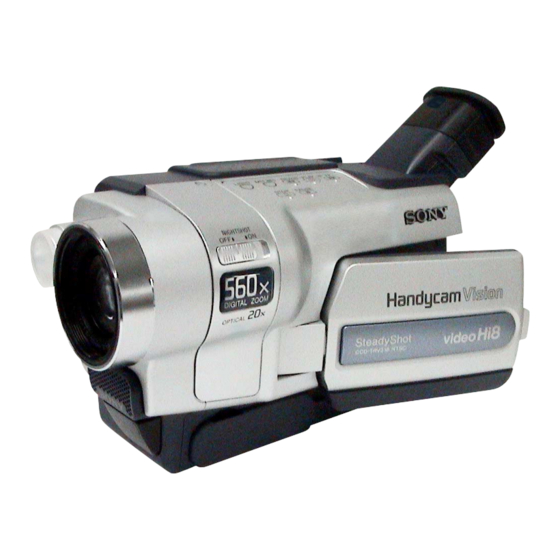
Sony CCD-TRV118 Service Manual
Hi8 video camera recorder
Hide thumbs
Also See for CCD-TRV118:
- Specifications (2 pages) ,
- Operating instructions manual (269 pages) ,
- Limited warranty (1 page)
Table of Contents
Advertisement
Quick Links
CCD-TRV118/TRV218E/TRV318/TRV418/TRV418E
SERVICE MANUAL
Ver 1.0 2002. 11
Revision History
Revision History
M2100/M2101 MECHANISM
Link
Link
SPECIFICATIONS
SPECIFICATIONS
SERVICE NOTE
SERVICE NOTE
DISASSEMBLY
DISASSEMBLY
NTSC MODEL: CCD-TRV118/TRV318/TRV418
PAL MODEL: CCD-TRV218E/TRV418E
• For ADJUSTMENTS (SECTION 6), refer to SERVICE MANUAL, ADJ (987625751.pdf).
• INSTRUCTION MANUAL is shown at the end of this document.
• For MECHANISM ADJUSTMENTS, refer to the "8mm Video MECHANICAL ADJUSTMENT MANUAL IX
M2000 MECHANISM " (9-929-861-11).
• Reference No. search on printed wiring boards is available.
• Table for differences of function of each model.
• When the machine needs to be repaired, make sure to follow the items of "LCD TYPE CHECK".
• HELP: Sheet attachment positions and procedures of processing the flexible boards/harnesses are shown.
Photo: CCD-TRV318
BLOCK DIAGRAMS
BLOCK DIAGRAMS
FRAME SCHEMATIC DIAGRAMS
FRAME SCHEMATIC DIAGRAMS
SCHEMATIC DIAGRAMS
SCHEMATIC DIAGRAMS
East European Model
North European Model
CCD-TRV118/TRV218E/TRV318/TRV418/TRV418E
Hong Kong Model
PRINTED WIRING BOARDS
PRINTED WIRING BOARDS
REPAIR PARTS LIST
REPAIR PARTS LIST
VIDEO CAMERA RECORDER
RMT-708
US Model
Canadian Model
CCD-TRV118/TRV318
AEP Model
CCD-TRV218E/TRV418E
UK Model
CCD-TRV218E
CCD-TRV218E/TRV418E
E Model
CCD-TRV218E
Australian Model
CCD-TRV218E/TRV418E
Korea Model
CCD-TRV418
Advertisement
Chapters
Table of Contents













Need help?
Do you have a question about the CCD-TRV118 and is the answer not in the manual?
Questions and answers